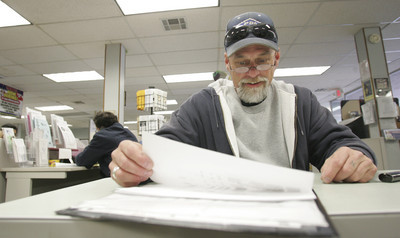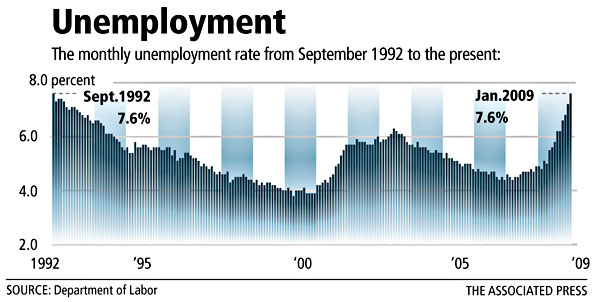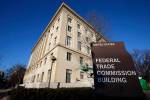Job losses increase in January
WASHINGTON -- The nation lost nearly 600,000 jobs last month, the worst showing in a third of a century, as a vicious cycle of cutbacks by consumers forced ever more layoffs by beleaguered employers. The unemployment rate catapulted to 7.6 percent, the highest in 16 years, and seems headed for double digits.
Some 3.6 million jobs have disappeared so far in a deepening recession, which is shaping up as the biggest job killer in the post-World War II period and is raising pressure on President Barack Obama and Congress to agree quickly on a huge economic stimulus plan to stop the hemorrhaging.
On Wall Street, investors optimistically assumed action was on the way and pushed stock prices higher. The Dow Jones industrials gained more than 217 points, and all broad stock indexes surged nearly 3 percent.
Battered by the recession, employers slashed a net 598,000 jobs in January, the most since 1974, the Labor Department reported Friday. The jobless rate surged from 7.2 percent in December to 7.6 percent, and economists and government officials all agreed the toll was certain to go higher.
"These numbers demand action," Obama declared, urging Congress to waste no time in completing work on the economic recovery package.
The jobs lost so far since the recession began in December 2007 are the most of any downturn in the post-war period. About half the losses occurred just in the past three months.
Layoffs this month are likely to be just as bad. And job seekers' prospects aren't likely to become noticeably better until 2011 -- at the earliest -- when job growth should return to a more healthy pace, analysts said.
Louis DiFilippo, 30, who was laid off in October from a food store in Washington, recalls seeing sales slowing. "I saw that something had to give," he remembers, "but I was hoping that it wouldn't be my position."
Unable to find a new job, he's going back to school.
Even if the recession were to end by fall -- a best-case scenario -- the economy and the job market would remain feeble for some time. Economists predict anywhere from 2 million to 3 million or more jobs will disappear this year and the unemployment rate probably will climb to 10 percent or higher by the spring of 2010.
"We're talking years -- not months -- before we see a decent recovery in the jobs market," predicted Sung Won Sohn, economist at the Martin Smith School of Business at California State University.
The pink slips are hitting all categories of workers -- blue collar, while collar, those without high school diplomas and those with college degrees. And they're sparing few occupations or corners of the country.
Vanishing jobs and evaporating wealth from sinking home values, 401(k) retirement plans and other investments have forced consumers to retrench. Those spending cutbacks have, in turn, led companies to pull back and slash jobs. As the cycle persists, the economy's problems are feeding on each other.
With no replacement work to be found, the ranks of unemployed workers climbed to 11.6 million. In addition, 7.8 million people were working part time. That category includes those who would like to work full time but whose hours were cut back or those who were unable to find full-time work.
The average work week in January stayed at 33.3 hours, matching the record low set in December.
If part-time employees, discouraged workers and others are factored in, the unemployment rate would have been 13.9 percent in January, the highest since 1994.
In other January figures:
• Factories slashed 207,000 jobs. That was the largest one-month drop since October 1982, partly reflecting heavy losses at plants making autos and related parts.
• Construction companies cut 111,000 jobs, professional and business services 121,000, retailers 45,000 and leisure and hospitality companies 28,000.
• There were gains for education and health services, as well as in government jobs, but those were swamped by the losses elsewhere.
Slideshow


























